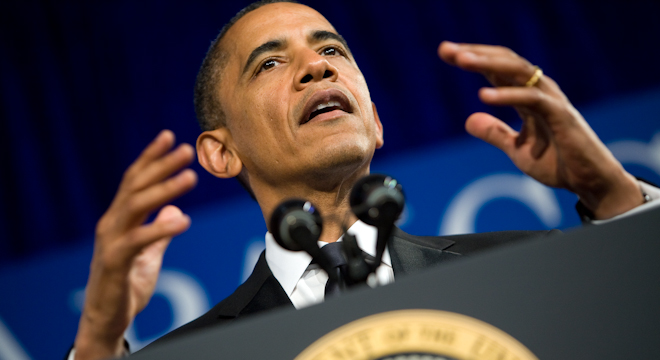At a public event in Albany, N.Y., Tuesday, President Obama went counterintuitive. Bloated government is a phenomenon of Republican leadership, he noted, and it’s helped them weather economic downturns in a way he hasn’t been able to.
“[A]fter there was a recession under Ronald Reagan, government employment went way up. It went up after the recessions under the first George Bush and the second George Bush,” he said. “So each time there was a recession with a Republican president, compensated — we compensated by making sure that government didn’t see a drastic reduction in employment. The only time government employment has gone down during a recession has been under me. So I make that point just so you don’t buy into this whole bloated government argument that you hear. And frankly, if Congress had said yes to helping states put teachers back to work and put the economy before our politics, then tens of thousands more teachers in New York would have a job right now. That is a fact. And that would mean not only a lower unemployment rate, but also more customers for business.”
As we’ve noted before, the numbers back this up completely.
Obama’s been hobbled by public-sector layoffs during this crisis in a way his predecessor George W. Bush never was back in 2001. Where the federal government stepped up to prevent states and municipalities from laying off teachers and other government workers in previous recessions, it’s fallen on its face under Obama.
More broadly, government spending at all levels rose steadily under Presidents Reagan and both Bushes, but was mostly flat under Clinton and has gone negative under Obama.
How does this phenomenon contribute to current economic woes? It’s impossible to know for sure. But if like the Wall Street Journal you imagine that the massive government job losses in Obama’s first term had never happened, then, all else equal, the unemployment rate right now would be down near 7 percent, a full percentage point below where it actually is.
But that’s not how the economy works. If those state and local workers had kept their jobs, they would’ve been making and spending money the whole time, which would have further boosted the economy and provided jobs for other people in the private sector. Economists call this the multiplier effect, and it would’ve pulled the unemployment rate down further. On the flip side, if that demand had never been subtracted from the economy, fewer people would’ve grown discouraged by the economic outlook and would’ve remained in the workforce — instead of dropping out entirely as they did in reality, in large numbers. That would have pushed the unemployment rate back up.
But broadly, the unemployment rate would be significantly lower than it is in the absence of the past three years’ public-sector job losses, which in turn were the direct consequence of the austerity Republicans at the state and federal level demanded.











